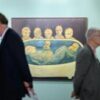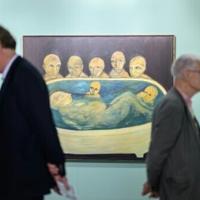May in New York is one of the biggest peaks in the art-world calendar, but this year’s wave of fairs and auctions comes as economic forecasts worsen in the US, and Israel’s ongoing war in Gaza continues to spark protests at university campuses in Manhattan and beyond. As interest rates have risen, lending on art has slowed as collectors play it safe. Meanwhile, speculation has dried up in the art market, particularly for the ultra-contemporary figurative artists who were so prevalent just two years ago.
“There are very few artists whose identity politics or whose personal story is worth multiple reads,” says one prominent US dealer who prefers to remain anonymous. As for addressing current political tensions, “the risk reward is extremely limited”, he adds.

Two’s company: David Zwirner (below) is showing works by Nate Lowman alongside furniture designed by Franz West Steven Molina Contreras
The chasm between the real world and the art world is perhaps wider than ever, and at Frieze New York, abstraction, neo-Pop and contemporary takes on Minimalism dominate the stands—safer bets in turbulent times. Gagosian is showing four monumental abstract paintings by Sterling Ruby priced at $550,000 each, as well as smaller collages priced in the tens of thousands of dollars. Two paintings sold as the fair opened on 1 May; VIPs in attendance included the CNN anchor Anderson Cooper, the pop star Kesha, the philanthropist Chelsea Clinton, Sharjah Art Foundation president Hoor Al Qasimi and Nicholas Cullinan, the new British Museum director.
Stands dedicated to two artists are also proving popular among dealers who are perhaps more interested in making a splash than racking up multiple sales. At David Zwirner, paintings by Nate Lowman that mine mass-produced imagery such as the Apple logo have been paired with furniture designed by Franz West. At Pace, spare pieces by the contemporary Minimalist Robert Mangold (priced at $350,000 to $450,000) are hung alongside sculptures by the American artist Arlene Shechet, whose work has grown in size and stature in recent years. By the end of the opening day, all of Shechet’s works had sold (prices ranged from $90,000 to $120,000).
Artists who have found critical acclaim later in life are prominent on the stand of the New York dealer David Lewis, who is showing pieces by Peter Schlesinger—who was David Hockney’s partner and muse—and the self-taught artist Thornton Dial (1928-2016). Both have occupied peripheral roles in traditional narratives of art history. “In a way it’s like showing emerging art, because it’s about sharing new stories,” Lewis says. “Emerging art and historical revisions have always gone together for me.” Schlesinger’s ceramic vase is priced at $50,000, while Dial’s Abstract relief is available for $400,000.
Lewis thinks the art market has been “slow these past couple of months”. He adds: “It’s been productive, but where that goes, we don’t know yet. New York is still the powerhouse, and Frieze New York has always been a great fair. Fairs accomplish things that gallery shows do not; the audience is prepped to receive information, and people’s minds are focused on making decisions.”
US collectors, particularly New Yorkers, remain a formidable force in the art market, though advisers are often sent to fairs in their stead, as was the case at Art Basel in Miami Beach in December and Frieze Los Angeles in February. “A lot of buying is being done by proxy,” says the anonymous US art dealer. By contrast, many high-profile collectors were spotted in the aisles at Frieze New York during Wednesday’s preview, including Helen Schwab, Dennis Scholl, and Carole Server and her husband Oliver Frankel.
New buyers are still entering the scene. The New York curator and adviser Amanda Schmitt brought her client, the San Francisco-based digital-art collector Andrew Jiang, to Frieze New York for the first time. Though Jiang didn’t purchase anything on his maiden art-fair voyage—the New York event is not well known for its digital offerings—Schmitt observes how her clients who have made millions in crypto are increasingly interested in acquiring physical art, particularly at the blue-chip level.
Museum exposure
Some of the most blue-chip works at Frieze New York can be seen on the booth of the Austrian dealer Thaddaeus Ropac, where prices rise to around $2m for works by Robert Rauschenberg. The majority of works hover around the $500,000 mark, however. Ropac is one of a number of galleries to capitalise on artists with current or upcoming exhibitions in museums and biennials, including Alex Katz and Martha Jungwirth, who have shows in Venice in parallel with the Biennale.

David Lewis is offering work by Peter Schlesinger (bottom) Steven Molina Contreras
Though the dealer thinks the market has softened compared with 2022, which was “a little bit out of the ordinary”, Ropac says that turnover at the fair is “still solid”. This is in large part down to New York collectors. “It’s astonishing,” he says. “On the whole, Europeans are not here; they are arriving next week [for The European Fine Art Fair]. But New Yorkers alone can support Frieze. I’m increasingly in favour of fairs that cater to their regions.”
Various sub-markets are reacting differently to the economic and political headwinds. As Alex Fitzgerald, a director at Andrew Kreps Gallery, puts it: “The art market isn’t just one monolith; there are different factions, and at times some of those do better than others. It’s often a balancing act.” Along with other artists, the gallery is showing works by Eileen Agar, the late British painter associated with the Surrealist movement who has not had a great deal of exposure in the US until now, and the New York painter Ricci Albenda, whose tongue-in-cheek text piece, Money is No Object (2021), is available for $40,000.
Many dealers are now eyeing up the New York auctions later this month as the next major bellwether of the overall health of the market. While the primary market—with its more accessible price points—remains relatively resilient, the secondary market is said to be more sluggish. Scarcity of material is another major factor, with cautious sellers holding on to their wares.
“If you look at the quality of what’s coming up in May, it’s pretty spotty,” says the anonymous US dealer. “No one died, no one got divorced. The auction houses are going to have real difficulty achieving yesterday’s prices in this marketplace.”
This post was originally published on this site be sure to check out more of their content






